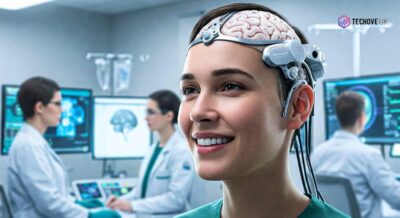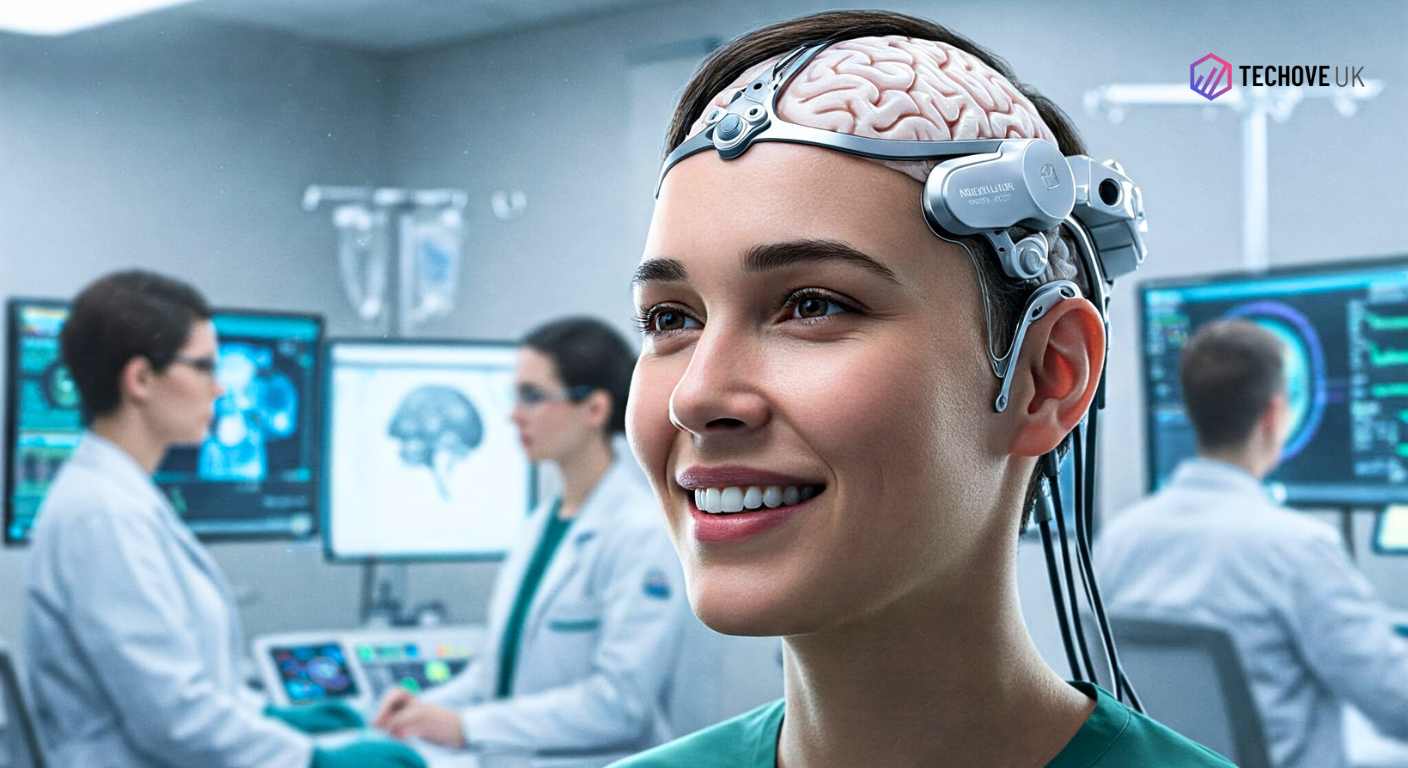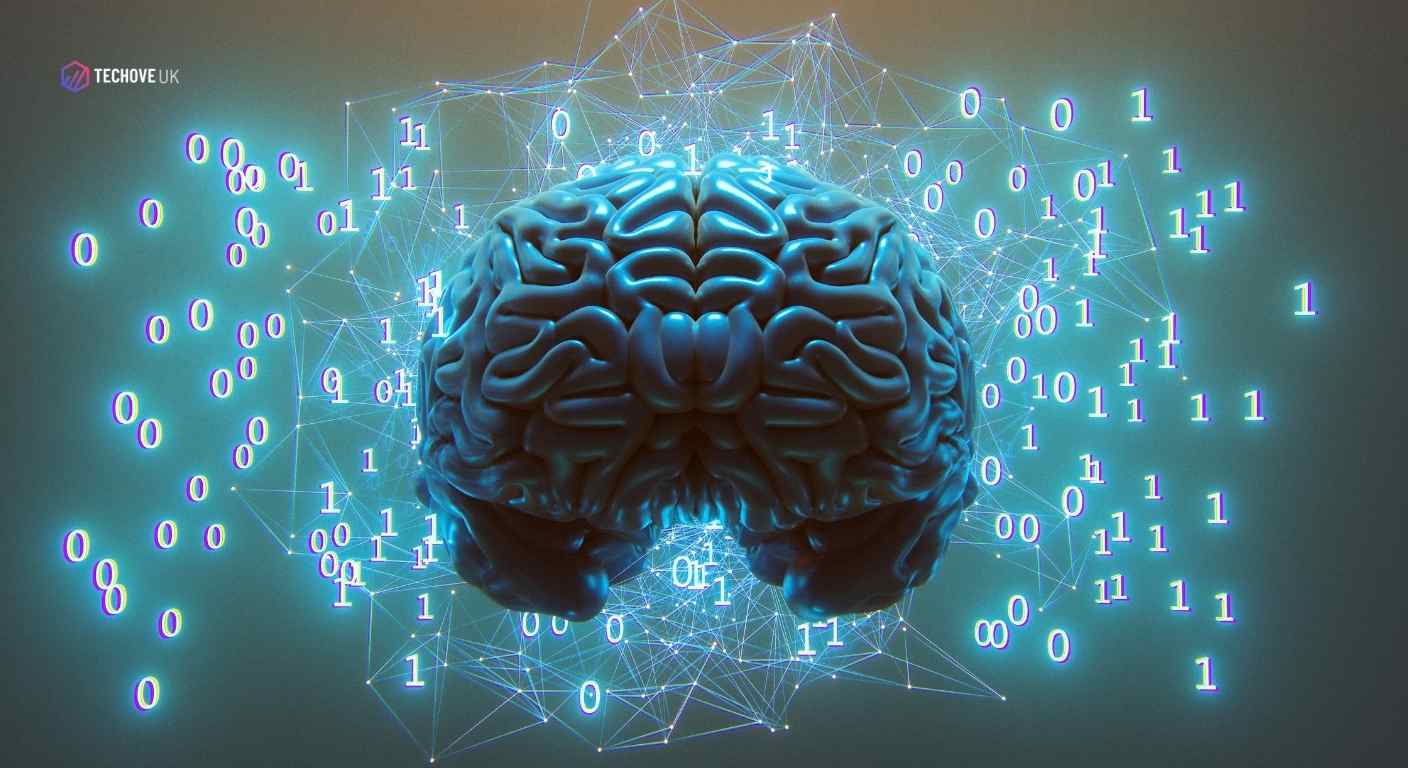Neuralink Human Trials: Inside Neuralink’s Pioneering Human Trials & Progress
Welcome to Techove UK. We can write our amazing content experiment about Neuralink Human Trials: Discover the Future of Brain Computer Interfaces? with powerful details and information.
Wow! Can you picture telling a computer what to do… just by thinking? Like, moving the mouse on the screen or playing a game with no hands? It sounds like magic or something from a superhero movie!
For a long time, it was just an idea. However, now some smart people are making it a reality. One company doing this is called Neuralink. You might have heard of it—it’s connected to Elon Musk. Neuralink works on brain technology. They are making tiny brain computer links. These links try to connect our brains straight to computers.
The biggest news right now is about the Neuralink Human Trials. This means they are testing their brain chip in real people for the first time! This is a huge step. One man who got the chip is already showing us amazing things.
Did you know the first person with a Neuralink chip implant said it felt like having mind-control powers? Let’s learn about these Neuralink Human Trials. We’ll keep it super simple and see what it means for people.
What is Neuralink Trying to Do? What’s the Big Goal?
Neuralink aims to assist individuals experiencing issues with their brain or nervous system. Their first primary goal is to help individuals who are unable to move specific parts of their bodies. This is called paralysis. Perhaps they have injured their spine or have a disease that prevents them from moving their arms or legs.
How does Neuralink want to help? They use a tiny chip implant. This chip is safely inserted into the brain. The chip does a few cool things:
- It Listens: Your brain uses tiny electric signals when you think. The chip listens to these signals. It’s like listening to your brain whisper its thoughts.
- It Understands: The chip figures out what the brain signals mean. Like, “Oh, that signal means ‘move left’.”
- It Acts: The chip sends that meaning to a computer. Then the computer does what your brain wanted! Like moving the mouse pointer.
Think of the chip like a tiny helper living in the brain. It understands brain language and computer language. It helps them talk to each other. This special link is a brain-computer connection. Mr. Musk’s Neuralink brain project has big ideas for the future, but helping people who need it most is the first step.
Getting the Green Light: The Okay from the FDA
Before doctors can implant a new chip like this in a person, they must ensure it is safe and effective. In the United States, the FDA reviews new medical products. They are like the safety police for health care.
Neuralink had to present the FDA with numerous tests. They did tests in labs. They did tests on animals. They had to prove the chip implant was safe enough to try in people.
Getting FDA approval to start the Neuralink Human Trials was huge news! It meant the FDA looked at all the safety tests and said, “Okay, Neuralink. You can carefully start testing this chip on a few people.”
The FDA’s approval was the green light Neuralink needed. It showed that they took safety very seriously. Now, they could finally see if the chip could help real people.
✔️Related Post: 5 Neuro Tech Skills That Will Dominate the Job Market by 2030
Noland Arbaugh: The First Person with the Neuralink Chip!
Let’s talk about Noland Arbaugh. He is the first to receive the Neuralink chip implant in these trials. Noland is a brave young man. A few years ago, he had an accident while diving. After that, he was unable to move his body below the shoulders, and it was tough for him to use computers or phones.
Then, Noland joined the Neuralink Human Trials. Doctors carefully put the chip in his brain. After he healed, they turned the chip on. What happened next was amazing!
- Thinking Makes it Move! Noland discovered he could move the mouse pointer on a computer screen by thinking about it. Imagine wanting the pointer to go left, and it just goes left! How cool is that?
- Playing Games Again! He began playing games online, such as chess. He could think about his move, and the chip would help him make the move in the game. He even played a long match called Civilisation. He stayed up late playing, just because he finally could again!
- “Like Mind Control!” Noland shared his story online. He said using the chip felt like having “the Force” from Star Wars. He said it was like “telepathy” – like sending thoughts directly to the computer. He just thought where he wanted the pointer to go, and it went!
Noland Arbaugh’s story is terrific. It demonstrates how this brain computer link might help people regain some freedom. He is the first, and he is assisting Neuralink learn so much. He said the chip implant wasn’t perfect, but it had already changed his life. He showed real strength in the first one.
How Does the Chip ‘Hear’ Thoughts? (Easy Guide!)
Okay, it doesn’t hear thoughts like words. But how does the Neuralink chip implant (they call it the “Link”) turn thinking into computer actions? Here’s the simple story:
- Super Tiny Wires: The chip features more than 1,000 tiny wires, known as threads. These threads are thinner than your hair! A special robot puts the tips of these threads just a little bit into the top part of the brain. It goes in the area that plans movements. Think of it like gently placing tiny antennas in just the right spot.
- Listening Posts: Each tiny thread has listening spots on it. These spots are called electrodes. They listen for the small electrical sparks that brain cells use to communicate with each other. When you think “move my hand,” specific brain cells spark in a special pattern.
- Sending the Message: The chip implant is small, roughly the size of a coin. It gathers all the spark patterns heard by the threads. It cleans up the signals and sends them out through your skin using wireless power, like Wi-Fi. No wires coming out of the head! A computer nearby picks up the signals.
- Figuring Out the Pattern: The computer has special programs. These programs learn Noland Arbaugh‘s brain patterns. It knows that this pattern means “move up,” and that pattern means “click.” The more he uses it, the better the computer understands.
- Action! Once the computer understands the thought, it tells the mouse pointer what to do. So, Noland thinks, and the computer acts. It happens super fast!
This link – from brain sparks to computer clicks – is how this amazing Brain Computer Interface works!
New Things Can Have Hiccups: Challenges and Worries
Creating something entirely new, like this brain chip, is challenging. Things don’t always go perfectly the first time. The Neuralink Human Trials are designed to identify and address issues.
- A Small Problem: After Noland Arbaugh received his chip, Neuralink discovered that some of the tiny threads had moved back slightly from their original placement. This meant that fewer listening posts could hear the brain signals. The computer control wasn’t working quite as well as it first did. Think of it as if some tiny microphones got moved too far away.
- A Smart Fix: The Neuralink team worked hard. They changed the computer programs and improved their ability to understand the signals from the threads that were still in the optimal spots. This software fix helped Noland regain control of his computer and even improved further!
- Learning is Key: This shows why trials are so important. You learn what works and needs fixing when you try it in the real world.
Besides fixing technical problems, this kind of powerful brain computer technology makes us ask big questions:
- Is it Safe Long-Term? What happens after many years with a chip implant? Doctors need to monitor patients closely to ensure they remain healthy.
- Keeping Brains Private? Our brain signals are very private. Could someone hack the chip? How do we keep brain thoughts safe? This is a big worry.
- Fairness for Everyone? Will this amazing technology only be accessible to the rich? Or can everyone who needs it get help? Making it fair is essential.
- Changing Humans? Currently, the goal is to assist individuals with medical issues. However, Musk’s Neuralink brain project sometimes discusses making humans smarter or better. Should we do that? What does it mean to be human if we have chips in our brains?
These questions don’t have easy answers. We all need to discuss them as this technology continues to advance.
What Could Happen Next? The Future Dreams
Helping people control computers is just the start. Neuralink and other brain computer groups have even bigger dreams for the future:
- Helping Blind People See? Perhaps a chip could be connected to a camera. It could turn pictures into signals that the brain understands as sight, helping visually impaired people. It’s a big dream!
- Helping People Move Again? Could the chip send signals back to the body? Maybe it could tell the leg muscles to move, helping someone paralyzed walk. This is a very challenging but huge goal.
- Helping with Other Brain Problems? Could chips help people who have seizures (like epilepsy)? Or help with problems like Parkinson’s disease? Or even help people who feel very sad all the time (depression)? Maybe! Lots more research is needed.
These big ideas are still far away. It will take more Neuralink Human Trials, better chip implants, and many years of work. However, the first steps with Noland Arbaugh demonstrate that the basic idea can be effective.
Neuralink is Not Alone: A World of Brain Helpers
While Musk’s Neuralink brain company receives considerable attention, many other brilliant individuals worldwide are also working on brain-computer interfaces.
- Some groups make caps that people wear on their heads. These caps read brainwaves from the outside – no surgery needed!
- Other companies produce chips that sit on the brain, rather than being deeply embedded.
- Different groups focus on various problems, such as helping people communicate effectively or controlling robot arms.
It’s great that so many people are working on this! More ideas mean more chances to find ways to help people. The Neuralink Human Trials are exciting but part of a bigger story of new brain technology.
Conclusion: Neuralink Human Trials
The Neuralink Human Trials are a significant development. They offer a glimpse into the future—a future where we can connect our minds to machines in amazing new ways and where people with paralysis may regain some freedom.
Thanks to the FDA’s approval, which gives the green light, and brave individuals like Noland Arbaugh, this future is starting now. Noland’s story, of controlling a computer with his thoughts using a chip implant, gives hope to many people worldwide, perhaps even here in the UK, where we read this today.
Yes, there are challenges to solve. Chip implant technology needs to improve, and we need to think hard about safety and fairness. However, the Neuralink Human Trials have initiated something truly remarkable. They are helping unlock the future of Brain-Computer Interfaces. It feels like we just opened a fascinating new book!
What do you think about this brain chip technology? Does it make you feel excited? Or worried? What good things do you hope it can do? Let us know your thoughts!





